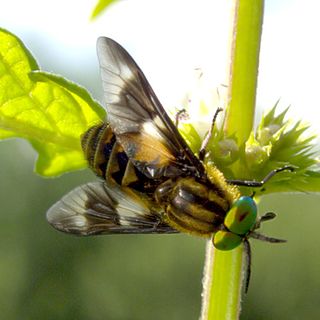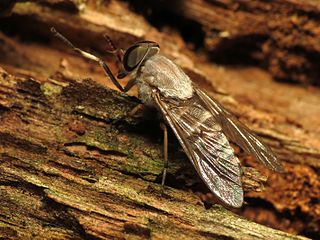
Horse-flies and deer flies are true flies in the family Tabanidae in the insect order Diptera. The adults are often large and agile in flight. Only female horseflies bite land vertebrates, including humans, to obtain blood. They prefer to fly in sunlight, avoiding dark and shady areas, and are inactive at night. They are found all over the world except for some islands and the polar regions. Both horse-flies and botflies (Oestridae) are sometimes referred to as gadflies.
Brennania is a genus of flies in family Tabanidae. It was originally known as Comops, created as a subgenus of Apatolestes by Brennan (1935). Philip (1941) then raised it to genus level, but renamed it to Brennania.
Asaphomyia is a genus of horse flies in the family Tabanidae.

Apatolestes is a genus of horse flies.

Superfamily Tabanoidea are insects in the order Diptera.

Haematopota is a genus of flies in the horse-fly family, Tabanidae. Among the horse-flies, they are most commonly known as clegs. Many species have colorful, sinuously patterned eyes in life, a character that fades after death. The wings are typically patterned with spots of grey. The genus is named from the Ancient Greek for blood-drinker: αἷμα, haîma, blood; πότης, pótës, drinker. Some species are known to be vectors of livestock diseases.
Cornelius Becker Philip (1900–1987) was an American entomologist, noted for assigning comedic names to species he described.

Leucotabanus is a genus of horse flies in the family Tabanidae.

Chlorotabanus crepuscularis is a species of horse flies in the family Tabanidae. This species is the only green tabanid in North America. It can be found from Texas to Delaware. In Florida, this sanguinivorous (blood-feeding) fly is seen as an adult from March through September, but is most active from May to mid-July.

Chlorotabanus is a genus of horse flies in the family Tabanidae. Though there were earlier descriptions of the genus, they did not fit the qualification of the Code of the International Zoological Nomenclature, thus the genus was officially accepted in 1913 by the scientific community.
Merycomyia whitneyi is a species of deer flies in the family Tabanidae. Larvae are known as sandworms and can be used as fish bait.
Hybomitra hinei is a species of horse fly in the family Tabanidae. A male Hybomitra hinei wrighti has been recorded reaching speeds of up to 145 km (90 mi) per hour when pursuing a female.
Hamatabanus is a genus of horse flies in the family Tabanidae.

Pangoniinae is a subfamily of horse-flies in the order Diptera, containing at seven tribes and over 40 genera.
Bolbodimyia is a genus of horse flies in the family Tabanidae.
Thaumastomyia is a genus of horse flies in the family Tabanidae.








